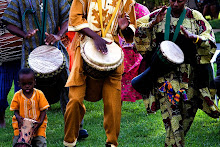 African Martial Arts:
African Martial Arts:While many naively associate Martial Arts simply from Asian sources. African has a long history of Martial Arts. Here is a list of only a few:
Angola Capoeira Angola Egypt Egyptian Stick Fencing
Eritrea Testa Nigeria Dambe South Africa Nguni Stick Fighting
Rough and Tumble Obnu Bilate Fanchento Senegal Laamb Wrestling Sudan
Nuba Fighting Togo Evala Wrestling
 "The earliest evidence of martial arts in Africa was discovered in the Beni Hasan tombs in Egypt, which date back to between 2040 and 1785 BCE, during the Middle Kingdom. In the tombs, archaeologists found paintings of wrestlers displaying techniques such as punching, kicking, throwing, and locking of their opponents’ joints. There is also evidence to suggest that ancient Egyptians performed stick fencing as a tribute to the Pharoah. Modern Egyptian stick fencing—the highly codified system of combat with its own methodology, weaponry, and training syllabus—was developed to keep the Egyptian armed forces trained and ready for battle."
"The earliest evidence of martial arts in Africa was discovered in the Beni Hasan tombs in Egypt, which date back to between 2040 and 1785 BCE, during the Middle Kingdom. In the tombs, archaeologists found paintings of wrestlers displaying techniques such as punching, kicking, throwing, and locking of their opponents’ joints. There is also evidence to suggest that ancient Egyptians performed stick fencing as a tribute to the Pharoah. Modern Egyptian stick fencing—the highly codified system of combat with its own methodology, weaponry, and training syllabus—was developed to keep the Egyptian armed forces trained and ready for battle."http://www.themmazone.net/Martial-Arts-WP/2008/12/01/african-martial-arts/
 1) Capoeira is a African-Brazilian blend of martial art, game, and dance originated in Brazil, from the regions known as Bahia, Pernambuco, Rio de Janeiro, Minas Gerais and São Paulo. The art-form started up in Brazil during the 16th Century, an obvious result of the slave trading that took place in conjunction with the previously slaved native Indians. Capoeira was created and developed by both the remaining native slave Indians in Brazil and slaves brought from Africa who brought with them a form of Martial arts from Africa. Participants form a roda (circle) and take turns playing instruments, singing, and sparring in pairs in the center of the circle. The game is marked by fluid acrobatic play, feints, and extensive use of groundwork, as well as sweeps, kicks, and headbutts. Less frequently-used techniques include elbow-strikes, slaps, punches, and body-throws.
1) Capoeira is a African-Brazilian blend of martial art, game, and dance originated in Brazil, from the regions known as Bahia, Pernambuco, Rio de Janeiro, Minas Gerais and São Paulo. The art-form started up in Brazil during the 16th Century, an obvious result of the slave trading that took place in conjunction with the previously slaved native Indians. Capoeira was created and developed by both the remaining native slave Indians in Brazil and slaves brought from Africa who brought with them a form of Martial arts from Africa. Participants form a roda (circle) and take turns playing instruments, singing, and sparring in pairs in the center of the circle. The game is marked by fluid acrobatic play, feints, and extensive use of groundwork, as well as sweeps, kicks, and headbutts. Less frequently-used techniques include elbow-strikes, slaps, punches, and body-throws.
As in the United States, slavery existed also in Brazil. The slaves were put to work in the plantations where sugar and tobacco were the main crops and the demand for slave labor was at an all-time high. During the history of the slave trade, it is estimated that more than two million slaves were brought to Brazil from Africa. They were brought to the port of Bahia. These captive Africans created the earliest form of Capoeira, a martial art, to increase their chances for liberty and independence. On the pretence of dance and religious gatherings, they practiced fighting techniques. Capoeira became an art form through which many liberated themselves.In Pernambuco, a group of forty slaves used Capoeira to rebel against their master and burn the plantation house. They then set themselves free and headed for the mountains. Eventually they reached what they thought was a safe place and named it Palmares, due to the abundance of palm trees. In this place, an African community was born, it lasted nearly a century and grew to a population of more than twenty thousand. These slaves came from different regions of Africa and thus had different cultures. Here, tribes that were enemies in Africa, united to fight for a common goal. After slavery was abolished on May 13, 1888, the planters no longer had interest in the ex-slaves as a work force, so most of them entered the cities and formed slums and shantytowns.




No comments:
Post a Comment